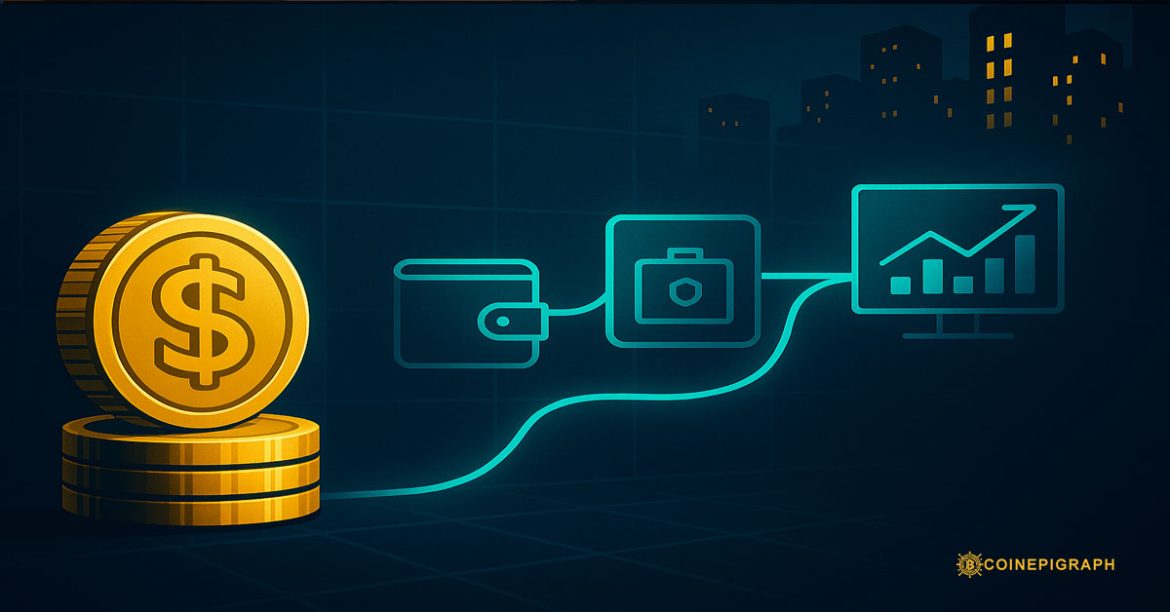By CoinEpigraph Research Desk • Oct 22, 2025 ET
Behind the headlines, tokenization competes on settlement quality—finality, all-in cost, and portability across venues. The interesting story is not that a new wrapper exists, but that some rails are already good enough for routine, non-theatrical use.
1) The claim in one line
Token rails win (or lose) on operational frictions. When finality arrives in minutes, costs are predictable per transfer size, and the dollars are portable across custody, venues, and apps, adoption shows up as mundane behavior: recurring disbursements, treasury sweeps, and tighter books in pairs linked to redeemable stablecoins.
2) What “settlement quality” means here
We use three practical yardsticks:
- Finality latency (L): time from initiation to economically safe settlement for the median transfer on a given rail.
- All-in cost per $10k (C): base fee + spread/slippage + operational touches (approval hops, FX, cutoff risk).
- Portability (P): how easily value moves between custody, market venues, and apps without bridging or manual exceptions.
Rails that score well on L, C, and P tend to surface the same downstream effects: books rebuild faster after volatility, spreads near mid are tighter during busy hours, and fewer transactions wait for off-hours batching.
3) Where token rails already look competitive
3.1 Minute-scale finality for routine tickets
On production L1/L2 rails used by mainstream stablecoins, minute-level (or faster) finality for mid-sized transfers is typical. That does not remove compliance or treasury policy gates; it reorders them. Instead of batching until end-of-day, teams can move working capital intra-day with fewer cutoff risks.
3.2 Predictable all-in costs in quiet tapes
Base network fees fluctuate, but effective cost per $10k on token rails is often stable relative to alternative rails once you include spread and slippage. In benign conditions, this favors recurring payouts and merchant flows where predictability matters more than the last basis point.
3.3 Portability across custody/venues
Digital dollars that are redeemable and accepted natively by custody stacks reduce the hop count between “wallet → venue → app.” That shows up as shorter approval chains and fewer exceptions. When the cash leg lives in stablecoins with broad off-ramps, redemptions look like operations, not events.
4) Observable patterns that align with improved rails
These are descriptive, not causal; they’re patterns commonly visible when token rails are used routinely:
- Depth distribution: more quotes within ±1–2% from mid in major pairs during U.S. and Asia overlaps.
- Spread behavior: median spreads stabilize earlier after shocks in pairs quoted vs redeemable stablecoins.
- Transfer rhythms: growth in small/medium recurring transfers (payroll-like bursts; supplier payments; programmatic treasury sweeps) uncorrelated with speculative spikes.
- Dispersion in stress: fewer spot/synthetic dislocations where off-ramp breadth is wide; more in wrapped/bridged corridors without direct redemption.
5) The composition story matters more than the headline
“Record stablecoin supply” is not one thing. The float mixes at least five buckets:
- Circulating balances — end-users and wallets using dollars as working capital.
- Treasury parking — programmatic or corporate holdings staged for deployment.
- Exchange inventory — venue hot/cold balances that grease matching and redemption.
- Merchant & payout rails — recurring disbursements, payroll-like bursts, commerce flows.
- Bridged/wrapped supply — interop artifacts that can inflate counts if double-counted.
These buckets react differently. Circulating balances and merchant rails tend to be stickier through modest price swings. Exchange inventory expands and contracts with activity and listings. Treasury parking grows around issuance/redemption cycles and incentive windows. Bridged supply depends on fees, outages, and where applications live; it can shift chains quickly.
Interpreting “record supply” benefits from a few cross-checks: issuer mix & redemption breadth; chain distribution; time-of-day rhythm; and venue footprint. Composition—not just totals—aligns better with how books feel during busy hours.
6) Where token rails still lag (and why it matters)
- Off-ramp breadth: narrow redemption channels push more adjustment into spreads when flows reverse.
- Issuer/custodian concentration: operationally efficient, but introduces single-point sensitivities (policy or operational).
- Policy/onboarding frictions: KYC and treasury policy steps add human latency even when network latency is low.
- Cross-chain accounting: wrapped corridors complicate which dollars are spendable where; misreads inflate perceived liquidity.
A rail can be fast and cheap in theory while still feeling slow in practice if the surrounding process (policy, custody, off-ramps) adds friction.
7) RWA pilots through the settlement lens
The practical gain for RWA isn’t the token; it’s the cash leg. Pilots move faster when the payable leg uses stablecoins that custodians accept natively and treasuries can reconcile without hand-offs. Issuance cadence and redemption cycles are less sensitive to bank cutoff times, and post-trade ops simplify when both legs compose inside the same custody stack. Where this isn’t true, pilots read like demos: attractive in slides, sticky in operations.
8) What to watch (observational signals, not predictions)
- Latency & cost drift: are minute-scale finality and sub-$ per $10k costs persistent at busy hours, or only off-peak?
- Issuer mix & redemption: does the share of directly redeemable dollars rise, and do spreads react less during volatility?
- Portability proxies: fewer explicit bridges in transaction paths; more straight-through movement between custody, venue, and app.
- Depth near the inside: does quoted size within ±1–2% rebuild faster after shocks where redeemable stablecoins dominate?
- RWA cadence: do pilot timelines compress (issue → settle → redeem) when the cash leg is on token rails?
9) Limits of this view
This focuses on operational behavior, not valuation. It does not imply direction for asset prices or recommend actions. Token rails can be operationally strong and still coexist with cyclical drawdowns, policy shocks, or venue-specific incidents.
Methods (appendix)
Scope & period. Use monthly snapshots over a multi-month window (e.g., last 6–12 months) to minimize single-event noise.
Metrics & construction.
- Finality latency (L): median time from broadcast to economically safe confirmation for transfers in the 25th–75th percentile size band per rail.
- All-in cost per $10k (C): base fee + observed spread/slippage + operational fees, normalized to $10k notional.
- Portability (P): qualitative score by hop count across custody/venue/app for common paths (0 = native; higher = more hops).
- Depth & spreads: quoted size within ±1% and ±2% from mid and median best-bid/ask spread during U.S./Asia overlaps, pre- and post-shock windows.
- Float composition: attribute balances to circulating, treasury parking, exchange inventory, merchant rails, bridged/wrapped using labeling heuristics and issuer/chain disclosures.
Caveats. Sampling bias around venue APIs, incomplete wallet labels, and cross-chain accounting differences can distort composition. Latency and cost vary with congestion and policy steps not visible on-chain.
At Coinepigraph, we pride ourselves on delivering cryptocurrency news with the utmost journalistic integrity and professionalism. Our dedicated team is committed to providing accurate, insightful, and unbiased reporting to keep you informed in the ever-evolving crypto landscape. Stay tuned as we expand our coverage to include new sections and thought-provoking op-eds, ensuring Coinepigraph remains your trusted source for all things crypto. -Ian Mayzberg Editor-in-Chief
The team at CoinEpigraph.com is committed to independent analysis and a clear view of the evolving digital asset order.
To help sustain our work and editorial independence, we would appreciate your support of any amount of Bitcoin/Satoshi to this address below: 3NM7AAdxxaJ7jUhZ2nyfgcheWkrquvCzRm
and through our Support Page.
🔍 Disclaimer: CoinEpigraph is for entertainment and information, not investment advice. Markets are volatile — always conduct your own research.
COINEPIGRAPH does not offer investment advice. Always conduct thorough research before making any market decisions regarding cryptocurrency or other asset classes. Past performance is not a reliable indicator of future outcomes. All rights reserved 2024-2025.




